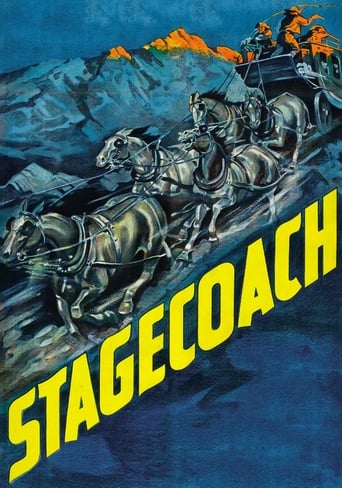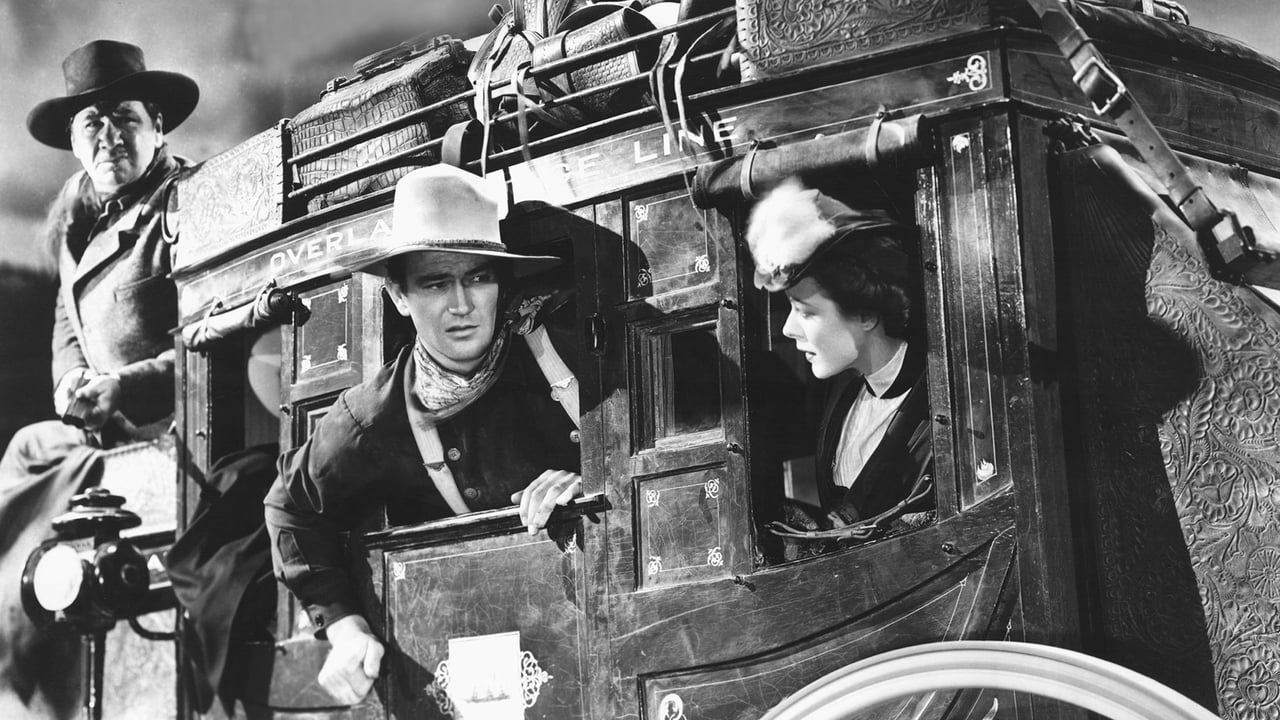SimonJack
Except for some oddities about it, "Stagecoach" would warrant all 10 stars. Fortunately, those don't detract from excellent acting all around in a movie with a great plot. The story in this film is engaging and keeps one interested with new and different twists. None of these is surprising – except for the pleasant one at the end. But, those keep one interested watching a bunch of folks traveling on a stagecoach. Many reviews discuss the plot, and the film billing tells what the story is about. So, after these overall accolades about plot and cast, I'll note the oddities that lower the film production down a notch. I think of "Stagecoach" as the "Casablanca" of Westerns. By that, I mean that it has a little bit of everything for the time and place. And, it just seems to capture the atmosphere of the place and time in history. The film has a great cast with an engaging story. "Casablanca" had intrigue, World War II Vichy occupation and threats by Nazis, POWs on the run and others fleeing Germany, the fringe area just outside the cordon of the Nazis, black market, resistance, open market and regular business in an open city, night clubs with night life, and romance. "Stagecoach" has the Old West, Indian uprising, a pregnant woman traveling to be with her U.S Calvary husband, a saloon gal leaving town at the behest of the local prudence society, a clandestine bank robbery, an alcoholic doctor forced to change residences, an escaped criminal, a long stagecoach ride, and romance. Thomas Mitchell won best supporting actor for his role as Doc Boone. By now, most movie fans would know that "Stagecoach" was John Wayne's break-out film, as the Ringo Kid. "Duke" had made more movies before this than many movie stars make in a lifetime. He had more than 80 films under his belt, dating back to 1926. He had achieved some recognition for Westerns and sports films, but he mostly was stuck in the second-tier of movie makers before this. That all changed after 1939. He still made Westerns, but most were major studio productions with sound plots, sets and casts. And, he branched out with some drama, comedy and then war films. The rest of the cast is superb. It includes a later Oscar winner, Claire Trevor as Dallas, and Oscar nominee, George Bancroft, as Marshal Curley Wilcox. Others are some of the top supporting actors of the day – especially in, but not limited to, Westerns. Andy Devine is Buck, the stage driver. John Carradine is Hatfield, the professional gambler and former Civil War officer. Donald Meek is the traveling liquor salesman, whom Doc eagerly takes under wing. Tim Holt plays a cavalry officer, and other familiar faces have supporting roles. "Stagecoach" also won the Oscar for best musical score, and it had five other nominations, including best picture and best director. And that was in a year in which Hollywood produced more than a dozen truly great films, including "Gone With the Wind" that took home eight Oscars. "Stagecoach" and "The Wizard of Oz" each won two Oscars. These and any of the others of the 10 nominated for best picture would beat out most other films nominated since 2000, and many nominated in the last third of the 20th century. But, "Stagecoach" had some odd or nagging things about it as well. The first thing that struck me as very odd was Curley carrying a double barrel shotgun. Yes, he was riding "shotgun" on the stage, but they expected trouble with the Indians. His shotgun wouldn't be effective much beyond 75 yards and he is shooting at Indians clearly 100 to 200 yards away. And hitting them. For better reality, he should have had a rifle. Another oddity was the Indians. They all seemed to be older guys – many quite a bit older. It was usually the braves, the younger men, who went on the warpath. Then, when they arrive in Lordsburg, the stage first lets the women and wounded off. Then it keeps going down the street and when it stops, Dallas is already there. That seemed to be a continuity problem that was very obvious. John Ford supposedly discovered Monument Valley in Arizona and it became "the" place to film Westerns over the next couple of decades – at least for Ford. That area along the Arizona-Utah border is striking. It became a sort of icon of the territory of the West. In reality, most of the West is nothing like it – or has bits and pieces of what looks like Monument Valley among prairies, mountains, dry and lush valleys, etc. But Monument Valley is high country desert – with the desert climate to go with it. Only sagebrush grows there. The valley is just under 30 square miles and it lies entirely within the Navajo Indian Reservation. This movie shows the buttes of Monument Valley from just about every angle. It's hard to imagine anyone settling or living in a place like that, and indeed, no one did. So, when the stage pulls into a thriving town of Lordsburg, it's a stretch of the imagination. But for that little bit of unreality, "Stagecoach" is a fantastic film and one that generations to come should enjoy.
JohnHowardReid
Copyright 20 February 1939 by Walter Wanger Productions, Inc. A John Ford Production, presented by Walter Wanger. Released through United Artists. New York opening at the Radio City Music Hall, 2 March 1939 (ran 2 weeks). U.S. release: 3 March 1939. Australian release: 27 July 1939. 10 reels. 96 minutes.SYNOPSIS: New Mexico, 1884. Apaches on the warpath.NOTES: Thomas Mitchell, Best Supporting Actor (defeating Brian Aherne in Juarez; Harry Carey in Mr Smith Goes To Washington; Brian Donlevy in Beau Geste; and Claude Rains in Mr Smith Goes To Washington). Best Adapted Music Score, Richard Hageman, Frank Harling, John Leipold, and Leo Shuken, defeating a line-up of 12 other scores including a Korngold and a Copland. Also nominated for Best Picture (Gone With The Wind); Directing (GWTW); Cinematography (Wuthering Heights); Art Direction (GWTW); Film Editing (GWTW).Best Direction, John Ford — New York Film Critics. Negative cost: $600,000. Combined U.S.-Canadian gross from original and 1944 release: $1,300,000. Re-made in 1966 by Gordon Douglas, with Anne- Margret as Dallas, Alex Cord as Ringo and (interestingly) Bing Crosby as Doc Boone.COMMENT: "Stagecoach" is one of the most popular westerns ever made. The reasons are not hard to find: More action that you can poke 101 rifles at (including the most excitingly-staged Indian attack ever filmed), set against the most awesomely magnificent scenery, a cast of likable and seasoned players, and handsome production values including a jaunty music score which adds further momentum to an already pell-mell pace. Ford's craftsmanship — his eye for arresting detail and dramatic composition, his unerring sense of flow and movement, his ability to draw involving characterizations from his players — was never more evident. One of the most remarkable qualities of Ford's genius is his unerring ability to top himself. On paper, the Lordsburg shoot-out looks like becoming an anti-climax after the dynamic thrills of the stage chase. But Ford is more than equal to the challenge. That shoot-out is equally as edge-of-the- seat suspenseful because of Ford's imagination and skill. He is a master at creating atmosphere and mood, he has a feeling for people and places that lifts the action, characters, setting and dialogue of his scripts to the highest emotional plane of sympathy and involvement."Stagecoach" made John Wayne a major star, but although he was to make many outstanding movies in the rest of his career (some again with Ford), he never equaled the vitality, the unassuming doggedness of the Ringo Kid. This is the John Wayne that most moviegoers remember.AVAILABLE on an excellent Criterion DVD.
Hitchcoc
John Ford created a Western that has every element you can have. It has a bank robber, a pregnant lady, a man falsely accused, some bad guys that accused him, a prostitute with a heart of gold, gunfire, Indians, the cavalry coming in at the last minute, John Wayne who, of course, never did anything wrong. These people are all travelling on a stagecoach so it becomes ensemble acting as they try to keep alive and get where they're going. Ford was a master director with a great eye for the camera. In addition to some really good plot elements and characterization, we see camera angles, close-ups, a wide shots that give the uninitiated an excellent interpretation of the Old West. This is worth seeing if only because it is a benchmark film, not merely a Western.
Edgar Allan Pooh
. . . in the past 12 months, I decided to re-watch STAGECOACH prior to the firing of the first artillery rounds of America's Second Civil War (sometime Wednesday morning)--in case the Grid goes down--to see if it was half as good as THE HATEFUL EIGHT. What a letdown! It turns out that STAGECOACH was shot on the cheap in Black & White, even though GONE WITH THE WIND and THE WIZARD OF OZ were released in glorious color that same year (1939). Speaking of shot, I did NOT remember the final shootout scene BECAUSE THE SHOTS ARE ONLY HEARD, NOT SEEN (director John Ford probably could not figure out how to show blood in monochrome). Perhaps the best thing that can be said about STAGECOACH is that it may be Mr. Ford's most honest movie. The "Ringo Kid" (Wayne)'s heart's desire is to marry a hooker and move to Mexico (in Real Life, Il Duce's second wife WAS a Mexican hooker). Ex-Confederate soldier Hatfield is full of pompous Chivalry but devoid of Brains--he saves only ONE bullet to murder Lucy, totally forgetting about Lucy's daughter. As in Real Life with Today's pipeline scandals, the Native Americans get it Right, gunning down Hatfield BEFORE he can slay Lucy (and doom her kid to a grisly death). Finally, the Art of the Deal Businessman--Elsworth H. Gatewood--gets the just desserts ALL One Per Centers (Then and Now) so richly deserve, being hauled off to the clink for his financial shenanigans, as Donald J. Duck will be one day.



 AD
AD








